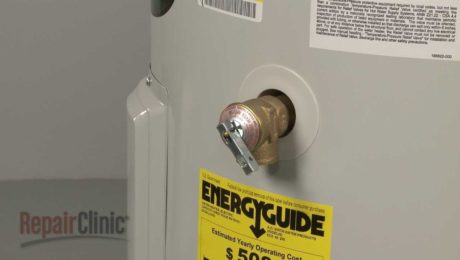5 Tips to Keep Your Water Heater Healthy
Most people would agree, hot water is important.
What you may not know, is when water is pumped in, dirt and minerals also make their way into your water heater, which makes the heater work harder, and unfortunately, causes it to slowly rust.
It sounds worse than it is. With the right maintenance, your water heater should last about 15
years, and fortunately, it’s not difficult. Here are five things you can do to keep things running smooth and efficiently.
1. To save on energy costs, turn the thermostat down to 120 degrees. For every 10 degrees you lower the temperature, you’ll save approximately 5% in energy.
2. Insulate older units to improve efficiency. This reduces heat loss by up to 45% which could shave an average of 9% off of your water heating costs.
3. Each year test the Temperature and Pressure Relief Valve (TPRV.) This valve prevents excessive pressure and keeps the water heater from exploding. To test the TPRV:
• Turn off the power and cold-water supply valves.
• Place a bucket underneath.
• Lift the valve to let some water out, then let go, if it keeps flowing or dripping, you’ll need to drain the tank partway and install a new valve.
4. Drain 1/4 of the tank a few times a year to remove sediment and debris, (and the heater will
run quieter.) To drain:
• Turn off the electric or gas to extinguish the pilot light.
• Hook up a garden hose to the drain and run water to the exterior or bathtub ten to fifteen minutes. Make sure no other hot fixtures are in use while performing this.
5. Change the Viable Anode Rod about every five years before it fails. Doing this could double the life of your water heater. The rod attracts corrosive elements and keeps them out of the water. However, when the rod itself gets corroded, it can’t do its job and the water heater could rust. (Do not remove it permanently or it will void manufacturers warranties.) There are a couple of options for the type of rod you use.
• A magnesium anode rod protects better but doesn’t last as long.
• Aluminum/zinc rods are cheaper and are recommended for smelly water.
• Be sure to consult a water treatment specialist before purchasing and installing a new rod.
- Published in Tips of the Trade
Pipes – Repair or Replace? That is the question…
Homeowners walk a fine line between maintaining existing plumbing fixtures and knowing when to bite the bullet and replace them. Weighing the cost of replacement with the potential cost of a plumbing mess isn’t easy so here are a few tips to help you assess the situation.
Pipes
First things first, figure out what kind of pipes you have and how old they are. Supply pipes made of brass, copper or galvanized steel should last 80-100 years. Drain lines made of cast iron should also last this long. Polyvinyl Chloride (PVC) pipes generally last 25-40 years, but are traditionally known to break or leak. These figures can vary dramatically depending the quality of your water, the quality of the material used, and how well the systems have been maintained.
If your pipes are on the older side, it doesn’t necessarily mean they have to be replaced. However, if you have lead or polybutylene pipes they should be replaced regardless. Lead leaches into drinking water and polybutylene is extremely prone to leakage.
Check areas around pipes for discoloration, stains, dimpling, or flaking, which could mean you have a leak. If you see anything out of the ordinary, look for other leaks— chances are there’s more.
Watch the color of your water, especially after vacation when it hasn’t been running. If it’s a yellow or brownish color, you could have rust.
Do you have hard water? If so, you have an above average concentration of minerals like calcium and magnesium, which leaves scale, or a film, behind. This film can accumulate in your pipes and other water-involved fixtures, eroding them.
Fixtures
Fixtures are relatively inexpensive to replace and can save you money in the long run. Newer model faucets, showerheads and hoses generally reduce water usage and are more energy efficient. If you have leaks, it’s best to replace the entire fixture instead of trying to fix it.
Toilets
Toilets can last a long time, so it’s easy to say, “If it ain’t broke, don’t fix it,” but the improved water efficiency justifies the investment; not just for the money savings, but because it’s better for the environment.
Definitely replace the toilet if the porcelain is cracked, if it’s flushing poorly, constantly running, or has a hissing sound which means the float and fill valve may be wearing out. The handle alone can be replaced if it won’t flush, or if the toilet constantly runs.
Water Heaters
Traditional water heaters should last 10-15 years, and tankless heaters should be good for 20 years depending, again, on the quality of your water. Replace your conventional heater if the pilot light keeps going out, or if the circuit or breaker keeps tripping in a tankless water heater.
Other indicators it’s on it’s way out are if the burner or heating element is failing, the thermostat breaks, valves are sticking, or if there are leaks and rust around the heater.
Garbage Disposals
Garbage disposals should probably be replaced every 10 years. It’s time for a new one if you constantly get clogs, your food takes a long time to break down, you have to keep resetting the disposal, or if there is a lingering odor that won’t go away.
- Published in Tips of the Trade
Waste not, Want not
We know, updating your leaky faucets, high flow toilets and inefficient water heaters is not at the top of your “Wish List,” but making these few small improvements will add up to more than just savings on your water bill, it saves thousands of gallons of water.
Fortunately, knowing the importance of these simple fixes, the federal tax credits for energy efficiency have been renewed for purchases made in 2016 and retroactive purchases of EnergyStar Products in 2015.
There are many rebates, incentives and credits available to help lower the price tag, we’ve outlined a few of them below. Take advantage of them and make your home more efficient. Trust us, it’s worth the effort.
Water Heaters:
Water heating accounts for about 18% of energy use in your home. The average water heater lasts 10-15 years, and even if it’s still chugging, replacing with an efficient water heater makes financial sense. Not to mention, if the tank should rupture, you could have a real mess on your hands. For more information on selecting a water heater, rebates and other water saving tips check out this infographic from Energy.gov
• Residential Rebate for an Energy Star Heat Pump Water Heater; The Orlando Utilities Commission (OUI) will pay 100% of the cost up to $650.
Toilets:
The Environmental Protection Agency reports that toilets are by far the main source of water usage, accounting for almost 30% of an average home’s indoor water consumption. To give you perspective, older, inefficient toilets can use as much as 6 gallons of water per flush, whereas new models can use just 1.28 gallons per flush. This kind of savings could save billions of gallons of water each year.
• Orange County Utilities is accepting applications for $100 vouchers toward replacing high-flow toilets.
• Orlando Utilities Commission is offering a $50 rebate for replacing a toilet with a flow greater than 1.6 gallons per flush, with an ultra-low flow toilet of 1.6 gpf or less.
Faucets and Showerheads:
More than just being flat out annoying, leaky faucets and showerheads are a huge waste. One drip per second wastes 1,661 gallons of water and can cost up to $35 per year. (energy.gov)
Orange County Utilities offers a Showerhead Exchange during the month of April. Orange County Utilities water customers can receive up to three showerheads to replace showerheads that use 2.5 gallons per minute or more.
For more information go to:
• Florida Tax Credits, Rebates and Savings
• Or use the Rebate Finder on EPA.Gov
- Published in Tips of the Trade



